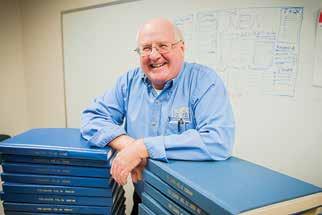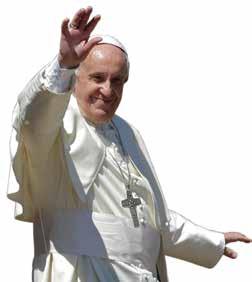
3 minute read
Easter: When we join our voices to the church’s joyful celebration
Christ is risen! Alleluia! He is truly risen! The discovery of the empty tomb is the biblical record of the historical event: Jesus’ bodily resurrection. No witnesses saw Jesus as he arose from the dead. But what they did see was Jesus’ passion, crucifixion and the empty tomb.
So, how did the disciples come to believe that God raised Jesus from the dead? And how is an artist to depict this central mystery of Christian faith?
Jem Sullivan
Sullivan is a professor at The Catholic University of America.

April 18
Wednesday Acts 5: 17-26
Ps 34: 2-9
Jn 3: 16-21
April 20
Thursday
Acts 5: 27-33
Ps 34: 2, 9, 17-20
Jn 3: 31-36
April 21
Anselm, bishop
Acts 5: 34-42
Ps 27: 1, 4, 13-14
Jn 6: 1-15
April 22
Saturday
Acts 6: 1-7
Ps 33: 1-2, 4-5, 18-19
Jn 6: 16-21
In a 19th century masterpiece titled “Two Disciples at the Tomb,” Henry Ossawa Tanner captures the dramatic moment described in the Gospel proclaimed on Easter Sunday morning. The remarkable painting invites us to enter into the Easter mystery with the same joy, hope and faith of Mary of Magdala, Peter and John — the first witnesses to Jesus’ resurrection.
We are told that Peter and John “ran” to Jesus’ tomb. Before them, Mary of Magdala had run to Peter and John to announce what she had found there. We might wonder why these Gospel figures are running — why they are in such haste at this pivotal moment on which the history of the world turns. Their eagerness evokes the deep longing of humanity for freedom from sin and despair. After Jesus’ crucifixion, the disciples recoiled in fear and abandonment. Mary’s witness offers a first glimmer of hope. She — called the “apostle to the apostles” by St. Thomas Aquinas — is a fearless messenger of hope to the disciples, who will, in turn, bear their witness to Jesus’ resurrection to the known world.
Tanner captures the moment when Peter and John stand before the empty tomb as they come to see and believe in Jesus’ resurrection. A warm golden light radiates from the dark tomb onto their astonished yet thoughtful faces. Just as they are bathed in the divine light of God’s power, so are we on this Easter day. The disciples’ gaze at the empty tomb is like our awe-filled contemplation of the mystery of Jesus’ resurrection.
God’s desire that we share in the divine life is the miracle of Easter morning. In the light of this supreme grace, we become courageous witnesses, like St. Peter in the first reading.
Human beings can forgive and receive forgiveness from each other. Only God can forgive the sins of all humanity, in every time and place. This is the good news of Easter.
Bathed in the radiant light of Jesus’ resurrection, we receive nothing less than divine life itself. Sin no longer has the last word on human existence.
Easter is the “feast of feasts,” when we join our voices to the church’s joyful celebration of Jesus’ victory over sin and death. Jesus’ resurrection is the pattern of the newness of divine life we are invited to live in every day.
As the joyful hope of Easter echoes within us, we become loving witnesses of the risen Jesus to a wounded world, as we pray with Easter faith, “Speak to me, Lord.”
Pope’s message of hope headed to space, audio beamed back to earth

VATICAN CITY (CNS) — Pope Francis’ message of hope for humanity will be shot into earth’s orbit as a “nanobook” embedded inside a small satellite and his words will also be transmitted back to earth each day for ham radio reception.
The new space mission, called “Spei Satelles,” is being promoted by the Dicastery for Communication and coordinated by the Italian Space
Agency (ASI). The project was unveiled at the Vatican March 27, the anniversary of Pope Francis’ prayer service he led in an empty St. Peter’s Square at the Vatican in the midst of the coronavirus pandemic in 2020.
Msgr. Lucio Adrián Ruiz, secretary of the Dicastery for Communication, said at the Vatican news conference that they have found many ways to spread the pope’s words and images from that historic evening three years ago: first as a global livestream, then a book “Why Are You Afraid? Have You No Faith?” which gathers together Pope Francis’ most significant speeches and comments during the pandemic. Now the book has been turned into a “nanobook” that will be housed in a low earth orbit satellite as a symbolic gesture of extending the pope’s loving embrace even farther. The satellite is scheduled to be launched from Vandenberg Base (VSFB) in California June 10.





